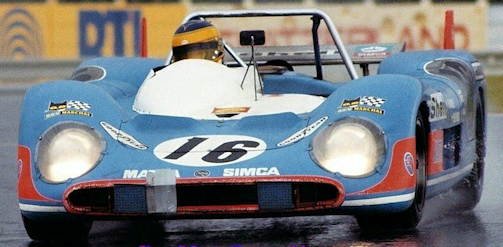Matra MS660 Race car
 |
|
|
Manufacturer: |
Matra |
|
Production: |
1969 to 1972 |
|
Class: |
Race car |
|
Top speed: |
199 mph, 320 km/h. |
|
Chassis/body: |
fibre composite plastics |
|
Engine and Powertrain |
|
|
Engine Type: |
12 cylinders |
|
Engine Displacement: |
183 cu in, 2899 cu cm |
|
Engine power: |
450 hp at 9,500 rpm |
|
Transmission: |
5 gears: mechanical |
|
Cooling: |
water |
|
Weights and Dimensions |
|
|
Wheelbase: |
98,43 in, 2,500 mm |
|
Length: |
165.35 in, 4,200 mm |
|
Width: |
76.30 in, 1,940 mm |
|
Dry weight: |
1309 1b, 630 kg |
The Matra MS660 was a sports car prototype that Matra used in the sports car world championship from 1969 to 1972.
History
The MS660 was the successor to the MS650 in contrast to the MS650, which still had a lattice frame, a monocoque chassis.The 12-cylinder engine with Lucas indirect injection system came, as in the MS650, from the Formula 1 - Matra MS11 With light alloy cylinder block and cylinder head with light alloy, flat-bottomed combustion chambers. The integral body with front trellis frame and engine at rear acting as the frame element.
PERFORMANCE
- max speed: 199 mph, 320 km/h.
- max power: 450 hp at 9,500 rpm
- specific power: 150 hp/l
The race debut had the MS660 1970 in Le Mans. The latest version of the three-litre prototype built by Matra is a proof of the constant refinement that is the out-
come of the experience gained in racing. The name Matra coupled with that of Simca due to commercial agreements. These cars have had their ups and downs during their development, partly due to the fact that they finished the raced against 'the big five-litre cars when their preparation was still being completed. In addition to two MS650 only one MS660 was used, which was controlled by the two long-time factory drivers Jean-Pierre Beltoise and Henri Pescarolo. The race was a complete disaster for Matra, as all three works cars in the seventh hour with engine failure. After the race it turned out that the defects were caused by defective piston rings.
In late 1970 there was the first and only race win for the MS660 in a sports car race. Three-time Formula One World Champion Jack Brabham, who also competed in Le Mans for Matra in 1970, and François Cevert won the 1000 km race in Paris at Montlhéry.
In 1971, the racing car did not finish as Jean-Pierre Beltoise at the 1000 km race in Buenos Aires had a momentous failure. On the 35th lap, the fifth-placed Beltoise ran out of gas just before the pits. Since it was only a few hundred meters to the pit system, Beltoise decided to push the MS660 there to refuel and hand over the vehicle to his teammate Jean-Pierre Jabouille. The Italian Ferrari pilot Ignazio Giunti at this point in time, he was in second place and had already passed the point of failure twice, warned by flag posts. But Beltoise had to push the car over the track to reach the pits.
In Le Mans Matra announced only one MS660 in 1971, as against the strong competition of Porsche and Ferrari with their 5-liter racing cars, an overall victory seemed not previously possible. Again, there was a failure. Beltoise and his race partner Chris Amon had their MS660 after 149 laps just before 2 clocks in the morning with a defect in the fuel injection shut off.
At the end of the year, the susceptible vehicles were successively replaced (in Le Mans in 1972 again a MS660 with David Hobbs and Jean-Pierre Jabouille at the start, failure due to clutch damage) by the new model MS670, with the 1972 Matra the first triumph at Le Mans.
Technical
-
Matra MS660 Technical details and specifications (1969-1972)
ENGINE
location rear
4 stroke; cylinders: 12, Vee-slanted at 60°
bore and stroke: 3.14 x 1.97 in, 79.7 x 50 mm
engine capacity: 183 cu in, 2899 cu cm
compression ratio: 11
cylinder block: light alloy
cylinder head: light alloy, flat-bottomed combustion chambers
valves: 4 per cylinder, vertical
camshafts: 2 per cylinder block, overhead
lubrication: gear pump, 'dry sump
lubricating system capacity: 26.4 imp pt. 31.7 US pt
carburation: Lucas indirect injection system
cooling system: water.TRANSMISSION
driving wheels: rear
clutch: dry multiplates
gearbox: mechanical; gears: 5 + reverse
gear lever location: side
final drive: hypoid bevel, limited slip
tyres: 4.50/ 10.60 x 15 front, 5.50/15.30 x 15 rear.CHASSIS
integral body, front trellis frame and engine at rear acting as frame element
front suspension: independent, wishbones, coil springs, telescopic dampers
rear suspension; independent, trailing radius arms, coil springs, telescopic dampers.STEERING
rack-and-pinion.BRAKES
disc, dual circuit
ELECTRICAL EOUIPMENT
voltage: 12 V
ignition distributor: electronic syctern
DIMENSIONS AND WEIGHT
wheel base: 98,43 in, 2,500 mm;
front track: 59,06 in, 1.500 mm
rear track 59.06 in, 1,500 mm
overall length; 165.35 in, 4,200 mm
overall width: 76.30 in, 1,940 mm
dry weight: 1309 1b, 630 kg
fuel tank capacity; imp gal, 31,7 US gal(2 separate tanks).© Motor car History
